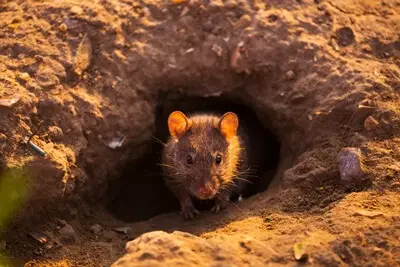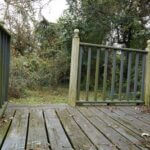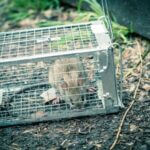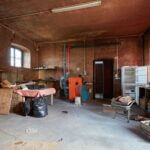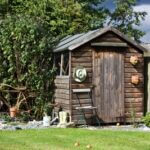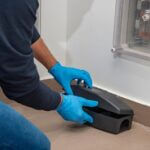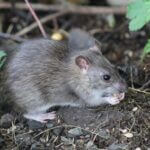Rats create underground pathways that lead to food sources, provide escape routes, and act as outdoor shelters. Most rat burrows are found under bushes and other dense vegetation.
You’ll need to find their exact location to get rid of rat burrows. They measure 2-4 inches at the entrance, and their interiors are smooth due to regular use.
Put a water hose in the entrance and flood the burrow. Rats will attempt to flee, but plugging the hole(s) will prevent that.
Put a deterrent around the burrow entrance, such as pepper powder, cinnamon, peppermint, or pine oil. These irritate rats’ eyes and nostrils, making it harder for them to burrow.
Block existing rat holes with steel wool, copper mesh, or concrete to render them inaccessible.
What Do Rat Burrows Look Like?
According to Oxford University, all rodents exhibit burrowing behaviors. So, it’s easy to mistake rat burrows for holes created by other pests, such as moles, voles, and gophers.
The openings of rat burrows measure about 2-4 inches in diameter. Moreover, freshly dug-up dirt is often strewn in a fan shape around the rim of the entrance.
Due to regular usage, you’ll notice that rat holes are smooth and have loosely packed soil.
How Deep Are Rat Burrows?
According to Applied Animal Behaviour Science, burrowing in rodents is a behavioral need.
Rats often dig burrows that are 8 inches deep to nest outdoors if they can’t secure an indoor shelter. However, they can dig deeper burrows if they believe there’s food on the other side.
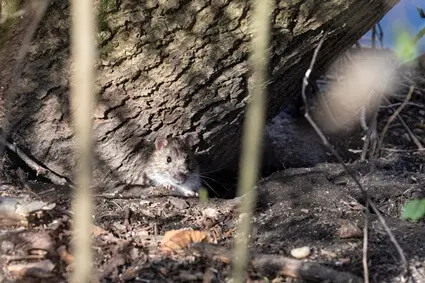
How Many Rats Live In a Burrow?
A single burrow can have 1-5 rats nesting inside it. Rats are social animals that prefer to live in packs.
Usually, the pack starts with one male and one female and grows as they reproduce. Since rats are territorial animals, they act aggressively toward any strange rat that attempts to enter their space.
How To Fill Rat Burrows
Filling up rat burrows around your property is vital for getting rid of rats because it disrupts their daily activity patterns and deprives them of nesting sites.
By blocking holes in your property, rats are forced to look elsewhere for shelter.
To fill rat burrows in your yard, plug steel wool inside the hole and apply caulk around it to keep the steel wool in place. These materials can be sourced from your local hardware store.
What Do I Fill Rat Burrows With?
Steel wire is the best material for filling rat holes since its tough and scratchy surface repels rats.
Alternatively, you can use copper mesh, aluminum foil, or concrete. Avoid using materials that rats can chew through easily, such as wood, foam, or plastic.
Can You Flood a Rat Burrow?
You can flood a rat burrow by hosing it down with water, and this flushes out any rats nesting inside the hole while also making it unappealing for any new rats in the future.
However, this doesn’t guarantee that they’ll permanently leave your yard. You’ll need to combine this strategy with other measures to keep rats out, including:
- Removing or sealing off rat attractants, like compost heaps, pet food, and garbage bins
- Sprinkling rat deterrents, such as ground pepper, around your garden
- Trimming your lawn and pruning your hedges.
How To Get Rid Of Rat Burrows Around Your House
Getting rid of rat burrows in your yard is crucial for keeping your property rat-free. If allowed to fester, rats can destroy your flowers, vegetables, and lawn with their burrowing habits.
They will also feed on nearby trash or plant life and eventually move into your home. The good news is that there are several measures that you can take to handle this problem.
Survey Your Property For Rat Burrows
You’ll need to identify potential sites for rat burrows around your property.
This will enable you to eliminate current ones and safeguard against future ones. You don’t want the rats moving to the next available place as soon as they’ve been driven out.
Rats like to dig burrows in areas with thick vegetation, as these places offer cover and protection from predators such as cats, dogs, and ferrets.
Therefore, when surveying your property for rat holes, you must pay close attention to areas under thick bushes, hedges, and tree bases.
Flush Out Rat Holes
Once you locate all rat burrows in your yard, you must flush them out. Take your water hose and douse the opening of the burrow. This will drive out rats that are nesting inside the hole.
Once the area has been disturbed, rats will be unwilling to return unless desperate. They’re aware that a predator has found their home and entered it.
If other burrowing sites have deterrents or predators near them, a rat may be desperate enough to return to the original burrow. So, seal off the burrow and surround it with strong-smelling deterrents.
Seal Off Burrow Entrances
After flushing out the burrows, seal them off to prevent rats from using them in the future.
The key is to fill the hole so that a rat can’t get back in. At the least, a rat should find it unpleasant to burrow in this location once more. You may choose to stuff the entrance with the following:
- Steel wool
- Aluminum foil
- Copper mesh
- Concrete
Of course, rodents can chew through most materials, including the ones listed. However, sealing all holes with a tough and scratchy material makes them less appealing to rats.
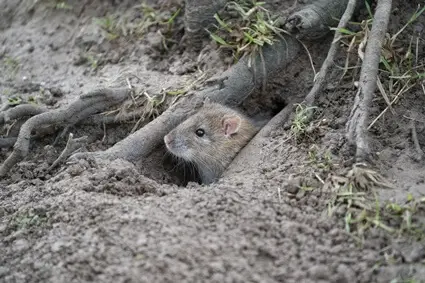
Deterrents Around The Hole
Apply a non-toxic deterrent to make rats even less likely to chew through the blockage. This can be placed in and around existing holes, but you should also use deterrents around potential burrows.
Spicy, powdered pepper is a great deterrent since it irritates rats’ nostrils and eyes. Burrowing is a hands-on endeavor, and rats will flee if their eyes burn and they struggle to breathe as they do so. This will encourage them to steer clear of any area where the deterrent has been applied.
Pepper doesn’t contaminate or damage any plants, fruits, or vegetables in your garden. Sprinkle the pepper around the rim of the hole and inside the hole to drive out any nesting rodents.
Alternatively, you may choose to use:
- Cinnamon oil.
- Pine oil.
- Peppermint oil.
Remove Water Sources
Now it’s time to drive off desperate rats. Unlike mice, which can survive on the little water they receive from their diet, rats require a reliable hydration source to stay alive.
Be careful if you have birdbaths, leaking pipes, dripping faucets, or unattended pet water bowls in your yard. Rats are likely to dig nests near these water sources.
Secure any open water source and repair damaged pipes to cut off rats from the water supply. This will make your yard less attractive to rats and force them to go elsewhere.
Maintain And Clean The Garden
Rats are more likely to dig burrows in areas with thick vegetation, bushes, and weeds. Therefore, keeping your yard unkempt will entice rats to nest there.
Proper waste management is crucial for preventing rats from nesting in your yard. Keep compost heaps covered and garbage cans sealed to deprive rats of food sources.

